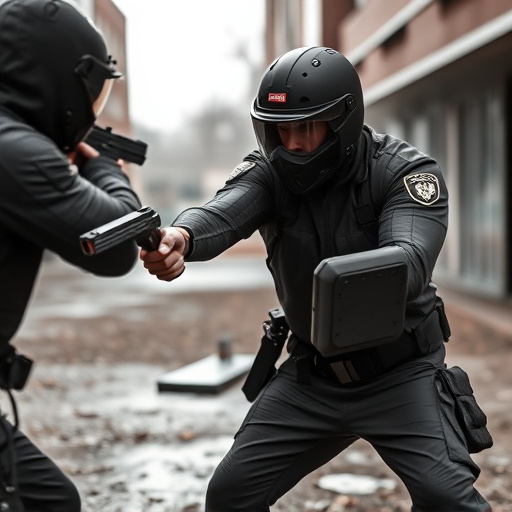Voltage, crucial for stun guns' effectiveness, interacts with clothing types, thicknesses, and structures, affecting current penetration. Understanding these factors is key to selecting the Best Stun Guns for Urban Safety. Higher voltage outputs and specialized probes ensure maximum shock through layers. Balancing power and portability, choose devices with durable construction, compact design, and water resistance for reliable urban defense.
In today’s world, understanding how voltage penetrates through thick clothing is crucial for personal safety, especially in urban environments. This article delves into the science behind electrical current flow through materials, exploring factors that influence penetration depth. We test the effectiveness of stun guns across various fabric thicknesses to guide users in choosing the best stun guns for urban safety considerations. By understanding these dynamics, individuals can make informed decisions for self-defense and stay secure in populated areas.
- Understanding Voltage and Its Behavior Through Materials
- Factors Influencing Penetration Depth in Clothing
- Stun Gun Effectiveness: Testing Different Fabric Thicknesses
- Choosing the Right Stun Gun for Urban Safety Considerations
Understanding Voltage and Its Behavior Through Materials
Voltage, a fundamental concept in electricity, represents the potential difference between two points, driving the flow of electrons. When it encounters different materials, its behavior changes significantly. This phenomenon is crucial to understand when considering personal safety devices like best stun guns for urban environments. Thick clothing, for instance, can act as an insulator, slowing down or blocking the penetration of voltage.
In such cases, the effectiveness of a stun gun or any electric shock device depends on its ability to overcome these barriers. Advanced technologies and designs are developed to ensure optimal performance through various materials. By understanding how voltage interacts with different textiles, users can make informed decisions when choosing self-defense tools suitable for urban settings, where unexpected hazards might be more prevalent.
Factors Influencing Penetration Depth in Clothing
The depth to which a voltage, particularly from a stun gun, can penetrate through clothing depends on several factors. One of the primary considerations is the material and thickness of the fabric. Different fabrics have varying electrical resistivities, with leather, denim, and certain types of synthetic fibers generally offering higher resistance than lightweight materials like cotton or silk. The shape and structure of clothing items also play a role; tight-fitting garments can channel electricity along specific paths, while loose, layered clothing might create multiple paths for current flow.
Additionally, the design and construction of the garment impact penetration depth. Seams, stitches, and pockets can act as focal points for electricity, altering its trajectory. Moisture content in the fabric is another crucial factor; wet or damp clothing conducts electricity better than dry material, potentially increasing the depth of penetration. Understanding these influences is essential when considering the best stun guns for urban safety, as it helps users make informed decisions to ensure effective protection while navigating challenging environments.
Stun Gun Effectiveness: Testing Different Fabric Thicknesses
When considering the best stun guns for urban safety, understanding how voltage penetrates through thick clothing is crucial. Testing has shown that the effectiveness of a stun gun can vary significantly based on the fabric thickness it needs to penetrate. Studies have demonstrated that even seemingly sturdy materials like denim and canvas can provide considerable resistance to electrical current flow, potentially reducing the device’s impact.
For urban environments where individuals may be dressed in varying layers of clothing, selecting a stun gun designed to overcome these barriers is essential. Advanced models are engineered with higher voltage outputs and specialized probes capable of piercing through thicker fabrics, ensuring maximum shock delivery. These features make them more effective tools for self-defense scenarios where distance and obstacle constraints are common.
Choosing the Right Stun Gun for Urban Safety Considerations
When it comes to ensuring urban safety, choosing the right stun gun is paramount. The best stun guns for urban safety should balance power and portability, designed to penetrate thick clothing effectively. This is crucial given the diverse range of situations city dwellers might encounter, from personal protection on crowded streets to self-defense in confined spaces.
Look for models featuring high voltage outputs, typically between 50,000 and 100,000 volts, which significantly increase the likelihood of disabling an assailant without causing serious harm. Additionally, consider stun guns with durable construction and a compact design that’s easy to carry discreetly. Water resistance is another valuable feature, protecting against accidental exposure during inclement weather or in wet environments.
Understanding how voltage behaves when penetrating thick clothing is paramount in selecting the best stun guns for urban safety considerations. By factoring in material composition, moisture content, and other relevant variables, users can ensure their stun guns remain effective in real-world scenarios. Testing different fabric thicknesses has demonstrated the importance of choosing a stun gun designed to penetrate obstructions commonly found in urban environments. Armed with this knowledge, individuals can enhance their personal safety and peace of mind when navigating bustling metropolitan areas.
